
The art of aerial photography with drones has a rich history, long before the invention of drone photography. This journey from the ground to the sky has been marked by pioneers, innovations, and a constant push towards new perspectives.
History of Drone Photography
The Pioneering Spirit of Nadar
Gaspard-Félix Tournachon, better known as Nadar, was a French photographer, caricaturist, and balloonist in the 19th century. He was among the first to understand the potential of capturing images from an aerial perspective. In 1858, Nadar took the first aerial photograph from a tethered balloon over the French village of Petit-Becetre. Although these initial photographs have not survived, they marked the beginning of aerial photography. Nadar’s passion wasn’t just limited to photography; he was also an avid balloonist, which allowed him to combine his two loves. His pioneering spirit laid the groundwork for the aerial and drone photography we know today.
The “New Vision” Movement in Photography
The early 20th century saw a shift in photographic perspectives, led by the “New Vision” movement. Photographers began to explore unconventional angles and perspectives, breaking away from traditional compositions. Aerial shots, extreme close-ups, and bird’s-eye views became popular, emphasizing abstract forms and patterns. This movement was not just about aesthetics; it was a reflection of the rapidly changing technological and urban landscapes of the time. The “New Vision” photographers, like László Moholy-Nagy, championed the idea that the camera could see the world in ways the human eye could not, a philosophy that resonates deeply with the ethos of drone photography.
Evolution from Traditional to Aerial Photography
From Nadar’s balloon expeditions to the “New Vision” perspectives, aerial photography continued to evolve. The two World Wars saw the strategic use of aerial reconnaissance, further advancing techniques and technologies. Post-war, with the advent of satellite imaging and commercial flight, aerial views became more commonplace, yet they remained largely the domain of professionals with access to aircraft.
The late 20th and early 21st centuries brought about a significant democratization of aerial photography. The development and commercialization of drones equipped with high-quality cameras made it possible for hobbyists, artists, and professionals to capture stunning aerial views without the need for planes or helicopters. Today, drone photography stands as a testament to humanity’s enduring desire to see the world from new heights, offering fresh perspectives on familiar landscapes and opening up entirely new vistas.
In conclusion, the history of drone photography is a tapestry of technological advancements, artistic movements, and pioneering individuals. From the adventurous spirit of Nadar to the abstract perspectives of the “New Vision” photographers, the journey to modern drone photography has been marked by innovation and a constant push towards new horizons.
Introduction to Drone Photography
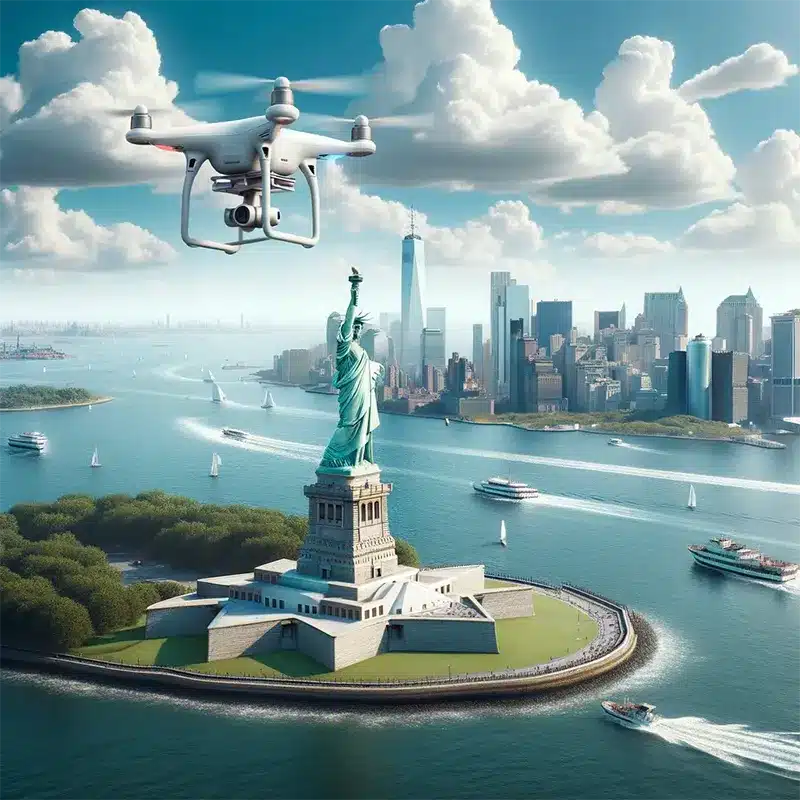
The world of photography has always been about capturing moments, emotions, and landscapes in their purest form. With the advent of drone technology, photographers have been given a new tool to elevate their craft, quite literally. This section delves into the essence of drone photography, its rise in the modern world, and the unique advantages it offers.
What is Drone Photography?
Drone photography is the art and science of capturing still images and videos from an airborne unmanned aerial vehicle (UAV), commonly known as a drone. Unlike traditional photography, where the photographer’s perspective is limited by their physical location, drone photography allows for capturing images from elevated vantage points. This aerial perspective offers a fresh take on familiar landscapes, revealing patterns, shapes, and compositions that are often missed from the ground.
The Rise of Drones in Modern Photography
The last decade has witnessed an exponential growth in the popularity of drones in photography. Several factors have contributed to this surge:
- Technological Advancements: Modern drones come equipped with high-resolution cameras, stabilization features, and advanced flight controls, making it easier for photographers to capture professional-quality images.
- Accessibility: Earlier, aerial shots were limited to those who could afford expensive helicopter rides or had access to tall structures. Drones have democratized aerial photography, making it accessible to hobbyists and professionals alike.
- Creative Freedom: Drones offer unparalleled creative freedom, allowing photographers to explore angles, elevations, and compositions that were previously unimaginable.
- Diverse Applications: From real estate and wedding photography to wildlife documentation and landscape artistry, drones have found applications in a myriad of photography genres.
Benefits of Using Drones for Photography
Drone photography isn’t just a trend; it offers tangible benefits that have revolutionized the way photographers approach their craft:
- Unique Perspectives: Drones allow photographers to capture bird’s-eye views, top-down shots, and sweeping panoramas, adding depth and dimension to their portfolios.
- Cost-Effective: Compared to traditional aerial photography methods, like chartering planes or helicopters, drones are a more cost-effective solution.
- Flexibility: Drones can be flown in various environments, whether it’s the tight confines of urban spaces or the vast expanses of natural landscapes.
- Safety: Drones can access hazardous or hard-to-reach areas, reducing the risks associated with capturing such shots.
- Innovation: The continuous evolution of drone technology, from automated flight patterns to obstacle detection, empowers photographers to push the boundaries of their creativity.
In essence, drone photography has reshaped the photographic landscape, offering fresh avenues for creativity and innovation. As technology continues to evolve, it’s evident that drones will remain an integral part of the photographer’s toolkit, pushing the boundaries of what’s possible in the realm of photography.
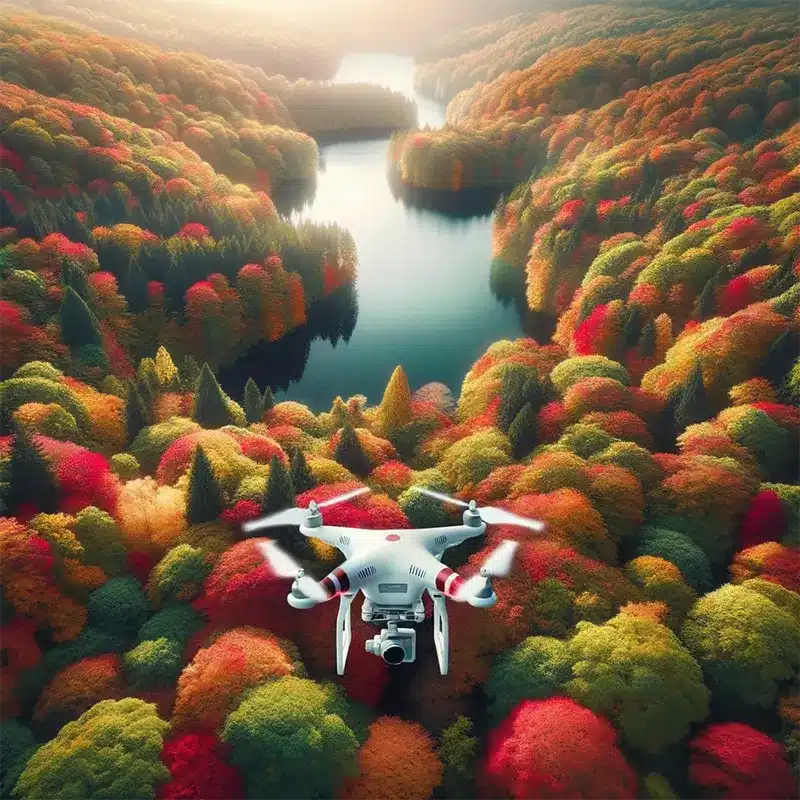
Traditional Photography Artists with Aerial-Like Perspectives
While drone photography has brought a fresh perspective to the world of photography, the allure of capturing the world from above is not a new phenomenon. Long before drones, several traditional photographers experimented with unique vantage points, techniques, and tools to achieve aerial-like perspectives. This section pays homage to some of these visionary artists whose work, in many ways, paved the path for today’s drone photography.
Yann Arthus-Bertrand
A renowned French photographer, Yann Arthus-Bertrand, is best known for his aerial photography series “Earth from Above.” Using helicopters and hot air balloons, he captured stunning landscapes, showcasing the beauty and fragility of our planet. His images, rich in color and detail, offer a bird’s-eye view of nature and human-made structures, reminiscent of modern drone photography.
George Steinmetz
George Steinmetz, with his lightweight motorized paraglider, has explored and photographed some of the most remote and inaccessible regions on Earth. His aerial shots, whether of vast deserts or intricate patterns of agricultural fields, bear a striking resemblance to the top-down shots popular in drone photography today.
Margaret Bourke-White
One of the pioneering female photographers of the 20th century, Margaret Bourke-White often captured industrial landscapes from high vantage points. Her iconic images of skyscrapers and cityscapes, taken from rooftops and aircraft, showcased urban life from a unique, elevated perspective.
Klaus Leidorf
A German aerial archaeologist and photographer, Klaus Leidorf, has been capturing aerial shots from a Cessna 172 plane since the 1980s. His work, which includes patterns of farmlands, archaeological sites, and urban structures, offers a mesmerizing blend of art and geometry, much like drone shots of today.
In conclusion, while drone photography might seem like a product of modern technology, the desire to capture the world from above has deep historical roots. These visionary artists, with their innovative methods and unique perspectives, have showcased that the essence of aerial photography lies not in the tools but in the artistic vision. Their work serves as an inspiration for drone photographers today, reminding us of the timeless allure of seeing the world from a bird’s-eye view.
Getting Started with Drone Photography
Embarking on the journey of drone photography can be both exhilarating and daunting. With the sky as your canvas, there are endless possibilities. However, mastering the art and technique of drone photography requires understanding the equipment, honing your flying skills, and integrating the principles of traditional photography. This section will guide you through the essentials of starting your drone photography journey.
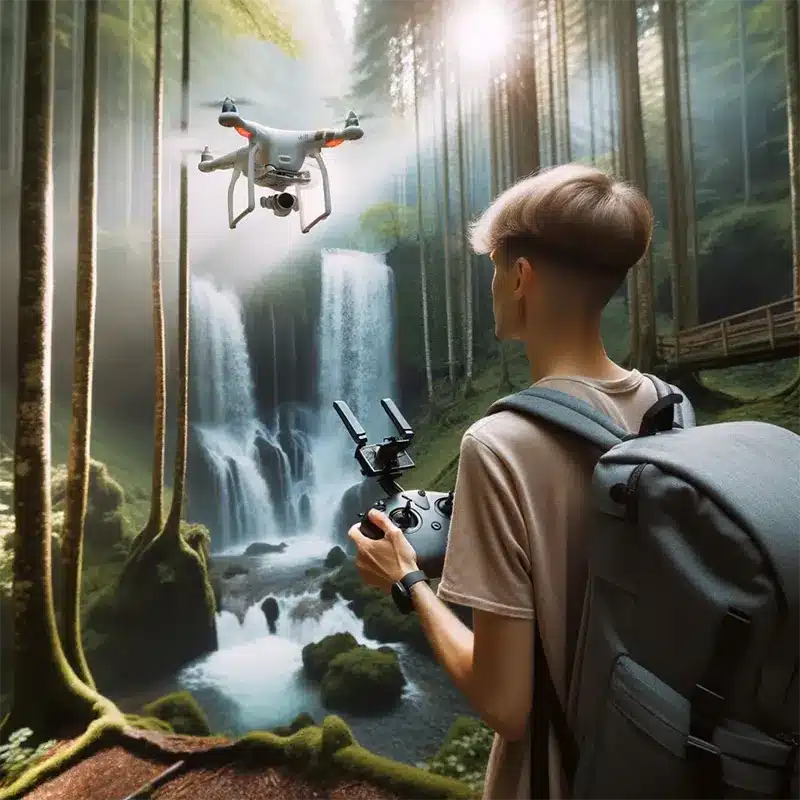
Is Drone Photography Right for You?
Before diving into the world of drones, it’s essential to assess if this form of photography aligns with your interests and goals.
- Passion for Technology: Drone photography is a blend of art and technology. A genuine interest in gadgets, technology, and flying can enhance your drone photography experience.
- Desire for New Perspectives: If you’re looking to break the monotony of traditional photography and explore fresh angles, drone photography offers a new world of perspectives.
- Commitment to Learning: Mastering drone photography requires patience, practice, and a commitment to continuous learning.
Choosing the Right Drone for Your Needs
The market is flooded with a plethora of drones, each catering to different needs and budgets.
- Best Drones for Beginners: For those new to the drone world, starting with user-friendly, budget-friendly drones like the DJI Mini or the Parrot Anafi can be a good choice. These drones offer essential features without overwhelming the user.
- Best Budget Drones: Drones like the Ryze Tello and the Holy Stone HS270 offer decent camera quality and flight features without breaking the bank.
- Drones Used by Professionals: For serious photographers and professionals, drones like the DJI Phantom 4 Pro or the DJI Mavic Air 2 offer advanced camera capabilities, longer flight times, and sophisticated flight features.
Learning the Basics of Flying a Drone
Before capturing stunning aerial shots, it’s crucial to be comfortable with flying your drone.
- Overcoming the Initial Fear: Start by flying in open spaces, away from obstacles. Use beginner modes available in many drones to get a feel for the controls.
- Basic Flight Controls and Techniques: Familiarize yourself with the drone’s controller. Understand the functions of each joystick, button, and setting. Practice basic maneuvers like ascending, descending, rotating, and moving in all directions.
- Safety First: Always be aware of your surroundings. Avoid flying near people, animals, or sensitive areas. Familiarize yourself with local drone regulations and always maintain a line of sight with your drone.
Integrating Photography Skills
While drones offer a new perspective, the principles of traditional photography still apply.
- Composition: Just as on the ground, consider the rule of thirds, leading lines, and framing when capturing aerial shots.
- Lighting: The golden hours of sunrise and sunset often provide the best lighting for drone photography, casting long shadows and offering a warm hue.
- Post-Processing: Drones capture vast landscapes, which might require post-processing for color correction, cropping, or enhancing details.
Starting with drone photography is a journey of continuous learning and exploration. With the right equipment, skills, and passion, the sky is not the limit; it’s just the beginning.
Choosing the Right Drone for Your Photography Needs
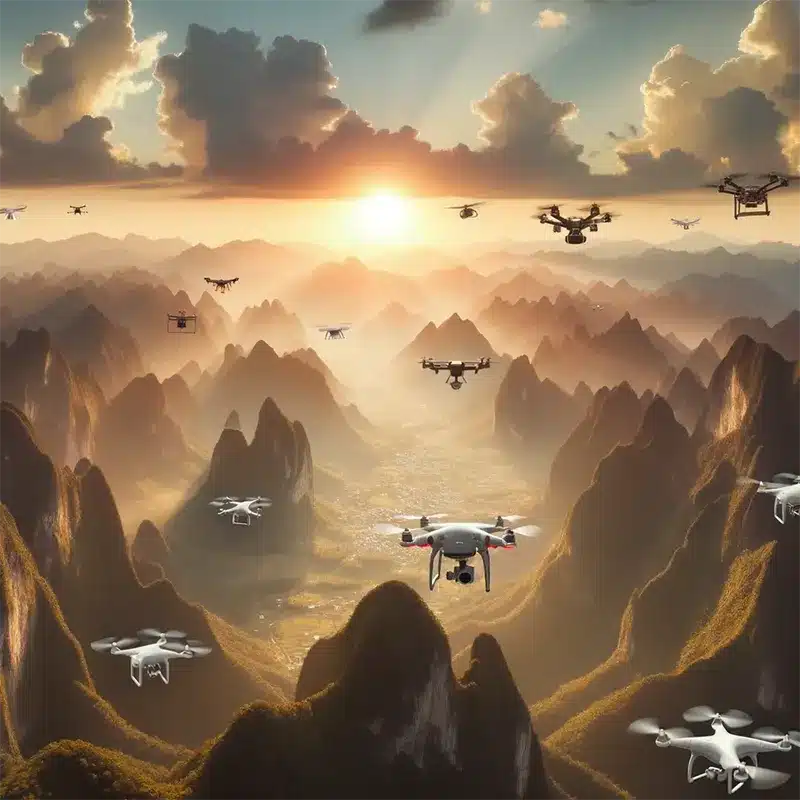
Drones have come a long way in terms of technology, features, and price points. Whether you’re a beginner or a professional, there’s a drone out there that’s perfect for your photography needs. Here’s a guide to help you make an informed decision:
DJI Mavic Mini
The DJI Mavic Mini is a compact, lightweight drone that’s perfect for beginners. Weighing just 249 grams, it doesn’t require FAA registration. It offers a 12MP camera and can shoot 2.7K Quad HD videos. With a 30-minute maximum flight time, it’s great for those looking to get started with drone photography without breaking the bank.
Parrot Anafi
The Parrot Anafi is another excellent choice for beginners and enthusiasts. It boasts a 4K HDR camera with a 180° tilt gimbal, allowing for some unique shooting perspectives. It’s compact, foldable, and offers a 25-minute flight time. The drone is also equipped with a x3 zoom, making it versatile for various photography needs.
Autel EVO Lite Series
Autel’s EVO Lite Series offers drones equipped with advanced features suitable for more serious photographers. They come with various camera options, including a 50MP option on the EVO Lite. These drones offer obstacle avoidance, a maximum flight altitude of 800 meters, and a top speed of 40.2 mph in ludicrous mode. They also support features like time-lapse, panoramic photography, and auto-follow.
Factors to Consider
When choosing a drone, consider the following:
- Camera Quality: Ensure the drone’s camera meets your photography needs in terms of resolution, aperture, and other features.
- Flight Time: Longer flight times mean more opportunities to capture the perfect shot.
- Range: A longer range allows you to capture shots from unique vantage points.
- Obstacle Avoidance: This feature is crucial for avoiding unwanted accidents.
- Price: Drones come in various price points. Determine your budget and find a drone that offers the best value for your money.
Answering Common Questions
- Best Drone for Starting a Photography Business: The DJI Mavic series, especially the Mavic 2 Pro, is highly recommended for its camera quality and reliability.
- Real Estate Drone Photography: Drones with high-resolution cameras and stable gimbals, like the DJI Phantom 4 Pro, are ideal.
- Drones Used by Professionals: Many professionals prefer the DJI Mavic 2 Pro, Phantom 4 Pro, and the Autel EVO Lite series for their advanced features and camera quality.
- Wedding Photography: Drones like the DJI Mavic Air 2 are popular for wedding photography due to their compact size and quality camera.
- Amazon’s Drones: Amazon uses custom-built drones for its Prime Air delivery service, which are not commercially available.
- Best Budget Drone: The DJI Mavic Mini offers excellent value for its price.
- Best Drone for $400: The DJI Mavic Mini and the Parrot Anafi are both great options in this price range.
- Cheap Drones: While they may lack advanced features, drones like the Ryze Tello offer decent quality for their price.
- Flight Altitude: Most consumer drones can fly up to 500 meters, but it’s essential to be aware of local regulations. In the US, the legal limit without special permission is 400 feet.
Remember, the best drone for you depends on your specific needs, budget, and the type of photography you’re interested in. Always prioritize safety, and ensure you’re familiar with local regulations before flying.
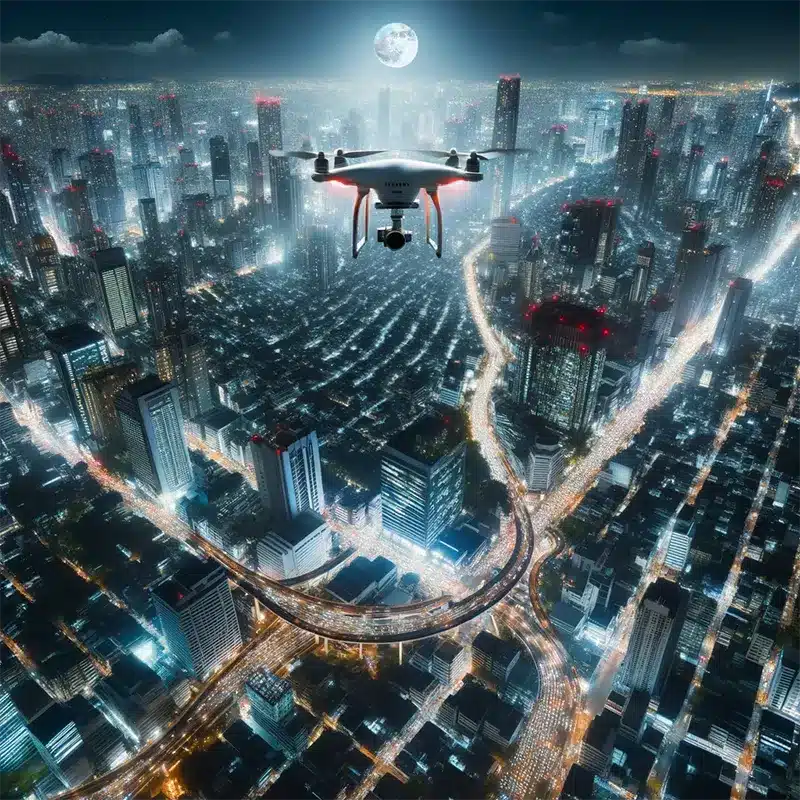
Mastering the Art of Drone Photography
While having the right equipment is essential, the true essence of drone photography lies in the skills and techniques employed by the photographer. This section delves into the intricacies of capturing breathtaking aerial shots, understanding the nuances of lighting, composition, and post-processing to elevate your drone photography to the next level.
Understanding Aerial Composition
Aerial composition differs significantly from traditional photography. Here’s how to make the most of your bird’s-eye view:
- Embrace Symmetry: Aerial views often reveal symmetrical patterns in nature and architecture. Use this to your advantage to create balanced compositions.
- Play with Shadows: The elongated shadows during the golden hours can add depth and drama to your shots.
- Use Leading Lines: Roads, rivers, and coastlines can act as natural leading lines, guiding the viewer’s eye through the image.
Lighting from Above
Lighting plays a pivotal role in photography, and with drones, you have a unique perspective:
- Golden Hours: Just like in traditional photography, the hours during sunrise and sunset offer soft, diffused light, ideal for aerial shots.
- Midday Challenges: While the midday sun can be harsh, it can also reveal underwater features in clear waters or emphasize the rich colors of landscapes.
- Overcast Conditions: Cloudy days can offer diffused light, reducing shadows and giving a unique mood to your shots.
Advanced Flying Techniques
To capture dynamic shots, mastering certain flying techniques is essential:
- The Orbit: Circling around a point of interest can provide captivating video footage.
- The Reveal: Start low behind a natural barrier and slowly ascend to reveal the landscape.
- The Tilt-Reveal: Keep the drone stationary while tilting the camera from a downward position to an upward position, revealing the horizon.
Post-Processing Aerial Shots
Even the most stunning drone shots can benefit from post-processing:
- Color Correction: Enhance the natural colors, especially in landscape shots, to make them pop.
- Cropping: Given the vast landscapes, sometimes cropping can help emphasize the main subject.
- HDR Processing: Combining multiple shots with different exposures can bring out details in shadows and highlights.
Staying Updated with Regulations
Drone photography isn’t just about capturing beautiful shots; it’s also about flying responsibly:
- FAA Regulations: In the US, the FAA has set guidelines for drone flying, which include not flying over 400 feet, not flying over people, and always maintaining a line of sight with the drone.
- No-Fly Zones: Areas near airports, government buildings, and national parks are often no-fly zones. Always check local regulations before flying.
- Respect Privacy: Avoid flying over private properties or capturing people without their consent.
Mastering drone photography is a blend of technical know-how, artistic vision, and responsible flying. With practice, patience, and continuous learning, you can capture the world from a perspective that truly stands out.
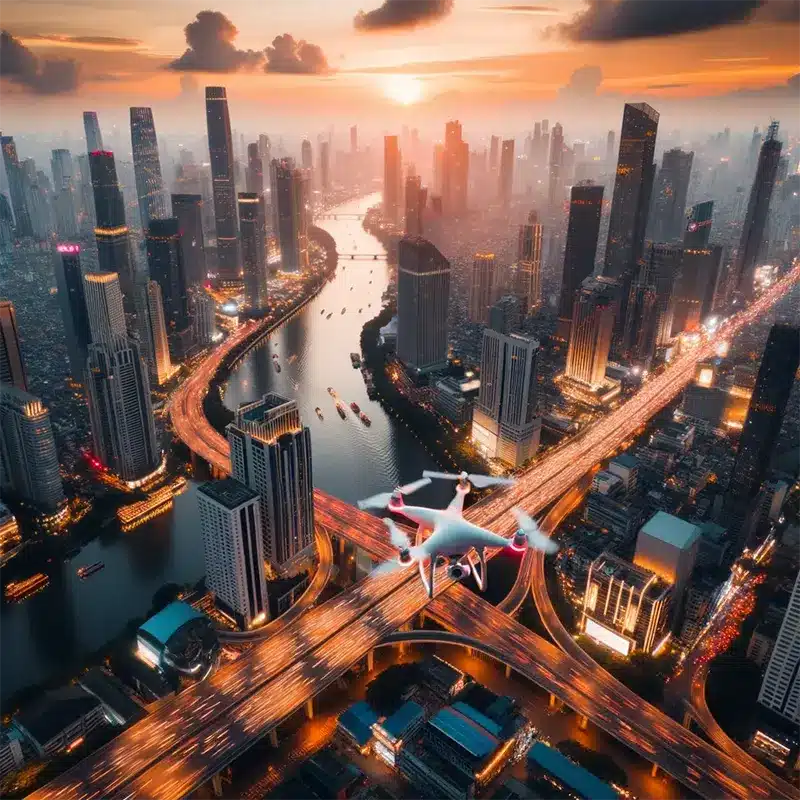
Monetizing Drone Photography
In the age of digital media, visual content reigns supreme. Drone photography, with its unique perspectives and breathtaking visuals, offers numerous avenues for monetization. Whether you’re looking to make a full-time career or a side hustle, understanding the business side of drone photography is crucial. This section will guide you through the potential revenue streams, pricing strategies, and tips to make your drone photography venture profitable.
The Profitability of Drone Photography
Drone photography has emerged as a lucrative field, thanks to its diverse applications:
- Real Estate: Aerial shots can showcase properties, especially large estates or those with unique landscapes, in their entirety, making listings more appealing.
- Weddings and Events: Drones can capture grand venues and large gatherings from above, adding a cinematic touch to wedding videos and event coverage.
- Commercial Projects: Businesses, especially in tourism, construction, and agriculture, are increasingly using drones for promotional content and operational needs.
Pricing: How Much Does Drone Photography Cost?
Determining the right pricing strategy is essential for a sustainable business:
- Package Deals: Offer bundled services, like aerial shots combined with ground photography or video editing, to provide more value.
- Hourly vs. Per Project: While some photographers charge by the hour, others prefer a per-project fee, especially for larger assignments.
- Licensing and Royalties: For stock photography or commercial projects, consider licensing your photos, which can provide passive income.
Building a Portfolio
A strong portfolio is your best marketing tool:
- Diverse Shots: Showcase a range of shots, from landscapes to urban scenes, to highlight your versatility.
- Personal Projects: Passion projects can often lead to your most creative work, helping you stand out.
- Online Presence: Maintain an updated website and active social media profiles to reach a wider audience and engage with potential clients.
Networking and Collaboration
Building relationships can open doors to lucrative projects:
- Collaborate with Other Photographers: Offer drone services to ground photographers who might need aerial shots for their projects.
- Engage with Local Businesses: Restaurants, hotels, and local attractions might need aerial content for their marketing efforts.
- Attend Workshops and Events: Networking events, photography workshops, and drone expos can help you connect with potential clients and collaborators.
Legal and Ethical Considerations
Ensuring you operate within legal and ethical boundaries is crucial:
- Obtain Necessary Licenses: In many countries, commercial drone operations require a license. Ensure you’re certified and always adhere to local regulations.
- Insurance: Consider getting drone insurance to protect against potential damages or liabilities.
- Respect Privacy: Always seek permission before flying over private property and avoid capturing individuals without consent.
In conclusion, while drone photography offers immense potential for monetization, success in this field requires a blend of technical expertise, business acumen, and ethical practices. With dedication and continuous learning, you can turn your passion for drone photography into a profitable venture.

Advanced Tips and Techniques for Drone Photography
As with any art form, mastering the basics of drone photography is just the beginning. To truly stand out and create mesmerizing aerial visuals, one must delve deeper into advanced techniques and creative approaches. This section will guide you through some expert tips, innovative methods, and nuanced techniques to elevate your drone photography to a professional level.
Mastering Camera Settings
Understanding and manipulating your drone’s camera settings can significantly impact the quality of your shots:
- Manual Mode: While automatic settings are convenient, manual mode gives you control over ISO, shutter speed, and aperture, allowing for better adaptability to lighting conditions.
- Use of Filters: Neutral density (ND) filters can help control light exposure, especially in bright conditions, ensuring smoother video footage and well-exposed photos.
- Bracketing: Many drones offer exposure bracketing, where multiple shots are taken at different exposures. These can be combined in post-processing for a well-balanced final image.
Creative Techniques in Flight
Innovative flight patterns can lead to captivating visuals:
- The Dolly Zoom: A classic cinematic technique, the dolly zoom involves flying the drone backward while zooming in (or vice versa), creating a unique visual effect.
- Top-Down Shots: Directly overhead shots can reveal interesting patterns and compositions, especially in landscapes or crowded areas.
- Fly-Throughs: Flying through tight spaces, like archways or between trees, can add a dynamic element to videos.
Storytelling with Drone Photography
Every shot should convey a story or emotion:
- Plan Your Narrative: Whether it’s showcasing the serenity of a landscape or the bustling energy of a city, have a clear narrative in mind.
- Use of Music and Sound: For drone videography, the right background score or natural sounds can enhance the storytelling element.
- Sequence Matters: When creating a video or photo series, the sequence can guide the viewer’s journey, ensuring a cohesive narrative.
Post-Processing Mastery
Post-processing can transform a good shot into a masterpiece:
- Color Grading: Enhance or modify the mood of your shots by adjusting color tones. Tools like Adobe Lightroom or DaVinci Resolve offer powerful color grading options.
- Panorama Stitching: Some drones offer in-built panorama modes, but manually shooting and then stitching images in software like Adobe Photoshop can provide higher-resolution results.
- Noise Reduction: For shots taken in low light or with high ISO settings, noise reduction in post-processing can lead to cleaner images.
Continuous Learning and Adaptation
The world of drone photography is ever-evolving:
- Stay Updated: New drone models, software updates, and photography techniques emerge regularly. Stay updated to remain at the forefront of the field.
- Join Communities: Online forums, social media groups, and local drone clubs can be valuable resources for learning, sharing, and getting feedback.
- Practice Makes Perfect: Regularly flying your drone, experimenting with new techniques, and reviewing your shots critically will lead to continuous improvement.
In essence, while the drone offers a unique perspective, it’s the photographer’s vision, creativity, and technical prowess that turn that perspective into art. By delving deep into advanced techniques and continuously honing your skills, you can achieve unparalleled excellence in drone photography.

While drone photography offers unparalleled perspectives and creative freedom, it’s not without its challenges. From technical hiccups to regulatory hurdles, drone photographers often face obstacles that require foresight, preparation, and adaptability. This section will shed light on common challenges and provide solutions to navigate them effectively.
Technical Difficulties
Drones, being technological marvels, can sometimes present technical challenges:
- Battery Life: Most consumer drones offer flight times between 20 to 30 minutes. Always carry extra batteries and be mindful of battery levels during flight.
- Signal Interference: Urban areas with many electronic devices can cause signal interference. Always ensure a strong connection between the controller and the drone.
- Equipment Malfunctions: Regular maintenance, firmware updates, and pre-flight checks can help prevent unexpected equipment failures.
Environmental Factors
Nature can sometimes be unpredictable:
- Weather Conditions: Wind, rain, and snow can affect flight stability and image quality. Always check weather forecasts and avoid flying in adverse conditions.
- Birds and Wildlife: Birds might see drones as threats. If birds start to approach, it’s advisable to descend slowly and land the drone.
- Magnetic Interference: Areas with high magnetic activity can affect the drone’s compass. Calibrate the drone’s compass in a neutral location before flying.
Regulatory and Legal Challenges
Drone photography is subject to various regulations:
- Flight Restrictions: Many countries have altitude limits, no-fly zones near airports, and other restrictions. Familiarize yourself with local regulations.
- Licensing and Certification: Commercial drone operations often require licenses. Ensure you have the necessary certifications.
- Privacy Concerns: Avoid capturing private properties or individuals without consent to respect privacy laws and ethical standards.
Mastering the Learning Curve
Drone photography requires a blend of flying skills and photographic techniques:
- Practice: Regular practice in different environments will enhance your flying skills and confidence.
- Continuous Learning: Drone technology and photography techniques are ever-evolving. Stay updated through workshops, online courses, and tutorials.
- Seek Feedback: Join drone photography communities to share your work and receive constructive feedback.
Ethical Considerations
Beyond laws and regulations, ethical considerations are paramount:
- Respect Nature: Avoid disturbing wildlife or sensitive ecosystems. Leave no trace and ensure your activities don’t harm the environment.
- Cultural Sensitivity: When capturing cultural events or landmarks, be respectful and aware of local customs and sentiments.
- Prioritize Safety: Never compromise on safety, whether it’s avoiding flying over crowds or ensuring your drone doesn’t pose a risk to others.
In conclusion, while challenges in drone photography are inevitable, they can be navigated with preparation, knowledge, and a commitment to ethical and responsible flying. Embracing these challenges as learning opportunities will not only make you a better drone photographer but also enrich your overall experience in this mesmerizing field.
Top Drone Photographers on Instagram
Instagram has become a hub for drone enthusiasts and professionals to showcase their unique aerial perspectives. Here are some of the most popular and influential drone photographers on the platform:
Dirk Dallas (@dirka)
Founder of “From Where I Drone,” Dirk Dallas’s feed is filled with mesmerizing aerial shots from various locations.
Gab Scanu (@gabscanu)
An Australian-based photographer, Gab Scanu captures breathtaking landscapes, especially the beaches and vast outback of Australia.
Tommy Clarke (@tommy.clarke)
Tommy Clarke is known for his vibrant aerial shots of beaches and coastal regions, encapsulating the essence of summer.
Renee Lusano (@wrenees)
Renee’s feed is a blend of her adventures and the stunning landscapes she captures, offering a fresh perspective on renowned places.
Benjamin Everett (@bejamin)
Not just a photographer, Benjamin Everett is an artist. He often merges multiple images to craft surreal and dreamy landscapes.
Alex Strohl (@alexstrohl)
While not strictly a drone photographer, Alex Strohl integrates aerial shots into his feed, complementing his narrative style of photography.
Tobias Hägg (@airpixels)
Tobias Hägg’s aerial photographs are poetic, often emphasizing the interplay between humanity and nature.
Jarrad Seng (@jarradseng)
Jarrad Seng’s work is a fusion of portraiture and landscape photography, often from an aerial viewpoint, capturing the grandeur of nature and human emotion.
Karanikolov (@karanikolov)
Known for his top-down aerial shots, Karanikolov offers a unique perspective, turning landscapes into abstract pieces of art.
Chase Guttman (@chaseguttman)
An award-winning travel photographer, Chase Guttman’s drone shots are a testament to his travels, capturing the essence of places he visits.
These talented drone photographers on Instagram offer a wealth of inspiration. Their feeds not only showcase the potential of drone photography but also provide insights into techniques and perspectives that make aerial shots truly stand out.
The Future of Drone Photography
The realm of drone photography is not static; it’s a dynamic field that continues to evolve with technological advancements, creative innovations, and changing societal needs. As we look ahead, it’s essential to understand the trends and developments that will shape the future of drone photography. This section offers a glimpse into what lies ahead and how these changes might influence both amateur and professional drone photographers.
Technological Advancements
The heart of drone photography lies in technology, and the future promises even more sophisticated tools:
- Enhanced Camera Capabilities: Expect drones to come equipped with cameras that offer higher resolutions, better low-light performance, and advanced features like 3D mapping.
- Improved Flight Times: As battery technology improves, drones will likely have extended flight durations, allowing for longer shooting sessions.
- AI and Automation: Drones of the future might have advanced AI capabilities, enabling automated subject tracking, intelligent obstacle avoidance, and even creative shot suggestions.
Expanding Applications
The use of drones in photography will expand into new horizons:
- Virtual Reality (VR) and Augmented Reality (AR): Drones could capture 360-degree footage for VR experiences or provide real-time data overlays for augmented reality applications.
- Environmental Monitoring: Drone photography will play a crucial role in monitoring climate change, deforestation, and other environmental challenges.
- News and Journalism: Real-time aerial coverage of events, protests, or natural disasters will provide unique perspectives in journalism.
Changing Regulatory Landscape
As drone usage becomes more widespread, regulations will evolve:
- Stricter Safety Protocols: With more drones in the sky, there might be stricter safety guidelines to prevent accidents.
- Privacy Laws: As drones become more integrated into daily life, privacy laws will likely become more stringent to protect individuals.
- Certification and Training: There might be more comprehensive training and certification programs for drone pilots, ensuring skilled and responsible flying.
New Avenues for Learning and Collaboration
The drone community will grow, offering more opportunities for learning and collaboration:
- Drone Photography Schools: As the field gains popularity, expect more formal educational institutions dedicated to drone photography.
- Global Competitions: Drone photography contests will become more prevalent, offering platforms for photographers to showcase their work on a global stage.
- Collaborative Projects: Drone photographers might collaborate on large-scale projects, combining their skills and expertise for grand visual narratives.
Ethical and Environmental Considerations
The future of drone photography will also be shaped by broader societal concerns:
- Sustainable Drones: As environmental concerns become paramount, drones made from sustainable materials or with eco-friendly features might become standard.
- Ethical Filming: Drone photographers will need to navigate the fine line between capturing compelling content and respecting cultural, personal, and ethical boundaries.
- Community Engagement: Drone photographers might engage more with local communities, ensuring their work benefits and respects the subjects they capture.
In essence, the future of drone photography is bright, filled with technological marvels, creative opportunities, and new challenges. By staying informed, adaptable, and ethically grounded, drone photographers can look forward to a future where the sky is not just a limit but a vast canvas waiting to be painted.
Essential Accessories and Tools for Drone Photography
To truly excel in drone photography, having the right drone is just the starting point. Equipping yourself with essential accessories and tools can significantly enhance your shooting experience, safeguard your equipment, and elevate the quality of your aerial shots. This section delves into must-have accessories and tools that every drone photographer, from beginners to professionals, should consider adding to their kit.
Protective Gear
Ensuring the safety and longevity of your drone and its components is paramount:
- Carrying Cases: A sturdy, waterproof carrying case can protect your drone from physical damage and the elements. DJI offers a range of protective cases suitable for various drone models.
- Propeller Guards: These guards shield the drone’s propellers from potential damage during minor collisions or rough landings. Check out the accessories section on the DJI website for compatible propeller guards.
- Landing Pads: A portable landing pad provides a clean, flat surface for takeoff and landing, protecting the drone from dirt, debris, and uneven terrains.
Flight Enhancements
Maximize your flight experience with these additions:
- Extra Batteries: Given the limited flight time of most drones, having extra batteries on hand ensures uninterrupted shooting sessions. DJI offers high-capacity batteries for extended flight times.
- Range Extenders: These devices boost the signal between the drone and the controller, allowing for longer flight distances.
- GPS Trackers: In case of signal loss or unexpected drone behavior, a GPS tracker can help locate and retrieve your drone.
Camera and Image Quality Boosters
Elevate the quality of your aerial shots with these tools:
- Lens Filters: Filters like polarizers or neutral density (ND) filters can enhance image quality by controlling light exposure and reducing reflections. DJI offers a variety of lens filters for different lighting conditions.
- Gimbal Stabilizers: While many drones come with built-in gimbals, external stabilizers can offer enhanced stability, especially in windy conditions.
- External Monitors: A larger, high-resolution monitor can provide a clearer view of your shots in real-time, aiding in composition and focus.
Data Management and Storage
With high-resolution images and videos, managing data is crucial:
- High-Capacity SD Cards: Ensure you have memory cards with fast write speeds and ample storage capacity to handle 4K videos and RAW images.
- Portable Hard Drives: For extended shooting sessions or trips, having portable hard drives can help back up and manage large volumes of data.
- Cloud Storage: Consider cloud storage solutions for an additional backup, easy access, and sharing capabilities.
Post-Processing Tools
The magic often happens in post-production:
- Editing Software: Tools like Adobe Lightroom, Photoshop, or DaVinci Resolve are essential for photo editing, color grading, and video editing.
- Calibration Tools: Monitor calibration tools ensure that colors are accurately represented during the editing process.
- Drone Mapping Software: For those interested in 3D mapping or topographical studies, specialized software can transform aerial shots into detailed maps.
In conclusion, while the drone is the star of the show, these accessories and tools play a pivotal role in enhancing the overall drone photography experience. Investing in the right accessories not only safeguards your equipment but also empowers you to capture the world from the skies with unparalleled precision and creativity.
Conclusion: Elevating the Art of Drone Photography
Drone photography, a blend of technology and artistry, has revolutionized the way we perceive and capture the world around us. From breathtaking aerial vistas to intimate top-down shots, drones have unlocked a realm of possibilities that traditional photography could only dream of. As we’ve journeyed through the intricacies of drone photography, from its rich history to its promising future, it’s evident that this form of photography is more than just a fleeting trend—it’s a transformative medium that’s here to stay.
The key to mastering drone photography lies not just in the equipment but in the passion, dedication, and continuous learning of the photographer. By equipping oneself with the right tools, understanding the challenges, and staying updated with the latest trends and techniques, photographers can elevate their craft to new heights.
Moreover, as drone technology continues to evolve, so will the opportunities and challenges it presents. It’s up to the drone photography community to navigate these changes responsibly, ethically, and creatively. By doing so, we can ensure that drone photography remains not just a tool for stunning visuals but also a medium for storytelling, exploration, and artistic expression.
In the end, whether you’re a seasoned professional or a budding enthusiast, remember that the sky is not the limit—it’s your canvas. Embrace the world of drone photography with an open heart and a curious mind, and let your creativity soar.